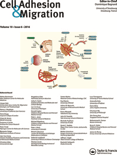
JOURNAL OF CELLULAR AND MOLECULAR MEDICINE
Scope & Guideline
Unlocking the Secrets of Life at the Cellular Level
Introduction
Aims and Scopes
- Cellular and Molecular Mechanisms of Disease:
The journal emphasizes research that elucidates the cellular and molecular mechanisms that contribute to various diseases, including cancer, cardiovascular diseases, and metabolic disorders. - Therapeutic Strategies and Drug Development:
It publishes studies related to novel therapeutic strategies, including drug design, repurposing, and the development of biologics targeting specific cellular pathways. - Translational Research:
The journal bridges basic research with clinical applications, focusing on findings that have the potential to influence clinical practices and improve patient outcomes. - Innovative Methodologies:
The journal encourages the use of cutting-edge methodologies, including high-throughput sequencing, single-cell analysis, and advanced imaging techniques, to explore cellular and molecular phenomena. - Interdisciplinary Approaches:
Research that integrates biology with bioinformatics, systems biology, and computational modeling is highlighted, reflecting the journal's commitment to a multidisciplinary approach in understanding complex biological questions.
Trending and Emerging
- Ferroptosis and Cell Death Mechanisms:
Research on ferroptosis, a form of regulated cell death distinct from apoptosis and necrosis, is gaining traction, highlighting its implications in cancer, neurodegeneration, and organ injury. - Exosome Research and Extracellular Vesicles:
The study of exosomes and their role in intercellular communication, immune responses, and disease progression is emerging as a significant trend, with potential therapeutic applications. - Microbiome and Gut-Brain Axis Studies:
There is an increasing focus on the interactions between the gut microbiome and various health conditions, including neurological diseases, reflecting a broader interest in holistic approaches to health. - Immunotherapy and Cancer Vaccines:
Research related to immunotherapy, particularly novel vaccine strategies and immune checkpoint inhibitors, is becoming more prominent, underscoring the shift towards harnessing the immune system in cancer treatment. - Machine Learning and AI in Biomedical Research:
The integration of machine learning and artificial intelligence in analyzing complex biological data sets is on the rise, indicating a trend toward data-driven approaches in cellular and molecular medicine.
Declining or Waning
- Traditional Pharmacology:
There has been a noticeable decrease in studies focusing solely on traditional pharmacological approaches, with a shift towards more innovative and personalized medicine strategies. - Basic Cell Biology:
Papers centered on fundamental cell biology without direct clinical implications appear to be less frequent, as the journal increasingly prioritizes translational research. - In Vivo Animal Studies:
Research involving extensive in vivo animal studies is becoming less common, as there is a growing emphasis on human-relevant models and in vitro studies that provide more immediate insights into clinical applications. - Single-Pathway Studies:
Studies focusing on isolated pathways without considering the broader biological context are declining, as the journal favors comprehensive analyses that consider network interactions and multi-target approaches.
Similar Journals

Physiology and Pharmacology
Fostering collaboration in the realms of physiology and pharmacology.Physiology and Pharmacology is a distinguished open access journal that has been disseminating high-quality research in the fields of physiology and pharmacology since its inception in 1997. Published by the Iranian Society of Physiology & Pharmacology, this journal offers a platform for scholars and practitioners to share innovative findings and advancements that contribute to the understanding of biological systems and drug action. With its ISSN 2476-5236 and E-ISSN 2476-5244, it ensures global reach and accessibility. The journal is positioned in the third quartile for Linguistics and Language and fourth quartile in both Pharmacology and Physiology categories according to Scopus rankings, reflecting a commitment to expanding knowledge within these interdisciplinary domains. Set within the academic landscape of Iran, the journal aims to bridge regional research with the international community, providing valuable insights into physiological processes and pharmacological developments. In light of its open access model, the Physiology and Pharmacology journal plays a crucial role in enhancing the visibility of research outcomes and fostering collaboration among researchers, professionals, and students on a global scale.

Frontiers in Molecular Biosciences
Transforming Research into Understanding in Molecular SciencesFrontiers in Molecular Biosciences is an esteemed open-access journal published by FRONTIERS MEDIA SA, based in Switzerland. Since its inception in 2014, the journal has made significant strides in the fields of biochemistry, genetics, and molecular biology, cementing its reputation with a solid position in the Q1 quartile for both Biochemistry and Genetics and Molecular Biology (miscellaneous) categories as of 2023. With a remarkable Scopus rank of #14/103 in the combined categories, it offers an essential platform for the dissemination of high-quality research that shapes the understanding of molecular processes and their implications in health and disease. The journal’s commitment to open access facilitates the broadest possible reach for groundbreaking discoveries, serving as a vital resource for researchers, professionals, and students alike. Located at AVENUE DU TRIBUNAL FEDERAL 34, LAUSANNE, this journal continues to foster innovative discussions and advancements in molecular biosciences, paving the way for new insights and collaborations in the scientific community.

MOLECULAR AND CELLULAR BIOCHEMISTRY
Unraveling the Mysteries of Molecular BiologyMOLECULAR AND CELLULAR BIOCHEMISTRY, an esteemed journal published by SPRINGER, serves as a prominent platform in the fields of biochemistry and molecular biology. With a history of dissemination since 1973, this journal has made significant contributions to the understanding of biochemical processes at the molecular level. The MOLECULAR AND CELLULAR BIOCHEMISTRY journal focuses on a myriad of topics including but not limited to cellular biochemistry, clinical biochemistry, and interdisciplinary approaches in medicine, boasting a commendable categorization in the 2023 Scopus ranks where it falls under Q3 in Cell Biology, Q2 in Clinical Biochemistry, Q1 in Medicine (miscellaneous), and Q2 in Molecular Biology. Although the journal is not open access, it provides access options through institutional subscriptions, making valuable research accessible to a wider audience. With its rigorous peer-review process and high impact within the scientific community, this journal aims to advance knowledge and stimulate exploration in biochemical research, making it essential reading for researchers, professionals, and students alike.

BIOSCIENCE REPORTS
Pioneering Insights in Biophysics and Molecular BiologyBIOSCIENCE REPORTS, published by Portland Press Ltd, is a prestigious journal dedicated to advancing the fields of biochemistry, biophysics, cell biology, and molecular biology. Founded in 1981, the journal has established itself as a vital resource for researchers and professionals, boasting a significant impact factor and high rankings within its categories, including Q2 in Biochemistry and Q1 in Biophysics as of 2023. The journal’s commitment to high-quality, peer-reviewed research ensures that it remains an influential platform for the dissemination of cutting-edge scientific findings. While it operates under a traditional subscription model, it offers various access options to accommodate the needs of the scientific community. With ongoing publication through 2024, BIOSCIENCE REPORTS continues to play a crucial role in shaping discussions in the life sciences and fostering innovative research in biology.

FREE RADICAL RESEARCH
Pioneering Research on Biological Free RadicalsFREE RADICAL RESEARCH, published by TAYLOR & FRANCIS LTD, stands at the forefront of studies in biochemistry and medicine, with a distinguished trajectory since its inception in 1985. This esteemed journal, which boasts an ISSN of 1071-5762 and an E-ISSN of 1029-2470, is recognized for its impactful contributions within the scientific community, as evidenced by its Q2 ranking in the 2023 category quartiles for both Biochemistry and miscellaneous Medicine. Utilizing rigorous peer-review standards, FREE RADICAL RESEARCH disseminates critical findings on the role of free radicals in biological systems, facilitating knowledge exchange among researchers, healthcare professionals, and students. Although it is not an open-access journal, its reach through academic databases ensures visibility and accessibility of groundbreaking research, making it an indispensable resource for those engaged in the dynamic fields of biochemistry and molecular biology. As the journal continues to evolve until 2024, it remains committed to advancing our understanding of oxidative stress and its implications for health and disease.

CELL BIOLOGY AND TOXICOLOGY
Exploring the Intersections of Life and ToxicityCELL BIOLOGY AND TOXICOLOGY, published by SPRINGER, stands as a vital journal within the realms of cell biology and toxicology, boasting an impressive 2023 Q1 ranking in its fields, alongside robust Scopus rankings placing it in the top 11th percentile for Toxicology and the 22nd for Health, Toxicology and Mutagenesis. With an ISSN of 0742-2091 and an E-ISSN of 1573-6822, the journal has been a cornerstone of scientific discourse since its inception in 1984, and will continue to converge innovative research until 2024. The journal focuses on the interplay between cellular mechanisms and toxicological implications, making it an essential resource for researchers, healthcare professionals, and students keen on advancing their understanding of these critical areas. Although it does not offer open access, its high impact and prestigious standing ensure that its publications reach a wide audience dedicated to significant advancements in the life sciences.

International Journal of Molecular and Cellular Medicine
Connecting Scholars in the Realm of Molecular MedicineInternational Journal of Molecular and Cellular Medicine, published by the CELLULAR & MOLECULAR BIOLOGY RESEARCH CENTER in Iran, is a leading platform dedicated to advancing research in various domains of molecular and cellular sciences. With an ISSN of 2251-9637 and E-ISSN 2251-9645, this journal features a rigorous peer-review process that ensures the publication of high-quality, impactful research. Spanning from 2016 to 2024, it is categorized in the third quartile (Q3) in Biochemistry, Cell Biology, Genetics, and Molecular Biology, and second quartile (Q2) in Biotechnology, underlining its significance in the scientific community. Although currently non-open access, it maintains credible visibility through Scopus rankings, reflecting its importance in fields such as Biochemistry, Molecular Medicine, and Genetics, where it holds respectable ranks and percentiles. This journal aims to foster collaboration and knowledge dissemination among researchers, professionals, and students in the pursuit of enhancing understanding and innovation in molecular and cellular medicine.

Cell Adhesion & Migration
Illuminating the Pathways of Cell MovementCell Adhesion & Migration, published by Taylor & Francis Inc, is a premier open access journal that has been providing a platform for the dissemination of high-quality research since its inception in 2007. With an emphasis on the critical roles that cell adhesion and migration play in various biological processes, this journal endeavors to publish cutting-edge studies in cell biology and cellular and molecular neuroscience. The journal's strong impact is reflected in its classification in the Q2 quartile for both Cell Biology and Cellular and Molecular Neuroscience categories as of 2023, underscoring its significance in advancing knowledge within the scientific community. The journal is accessible globally due to its open access model established in 2019, making it a valuable resource for researchers, professionals, and students aiming to explore innovative findings in cell dynamics and their implications in health and disease. With a commitment to fostering collaboration and dialogue among scientists, Cell Adhesion & Migration continues to be an essential resource in the rapidly evolving fields of cell biology and neuroscience.

JOURNAL OF CELLULAR BIOCHEMISTRY
Delivering Impactful Findings in Biochemistry and Cell BiologyJournal of Cellular Biochemistry is a premier academic journal dedicated to advancing the field of biochemistry and cellular biology. Published by Wiley, this influential journal has a significant impact factor that underscores its relevance and authority within the scientific community. With its ISSN 0730-2312 and E-ISSN 1097-4644, the journal has been on the frontier of research since its inception in 1982, and is expected to continue publishing cutting-edge studies through 2024. As evidenced by its ranking in the 2023 Scopus Quartiles, it holds a rank of Q2 in Biochemistry and Q3 in both Cell and Molecular Biology, placing it among the top tiers of scientific journals in these disciplines. The Journal of Cellular Biochemistry serves as a vital resource for researchers, professionals, and students alike, providing a platform for the dissemination of innovative ideas and findings that shape our understanding of cellular processes and biochemical pathways. Though it does not currently offer Open Access options, its robust peer-review process ensures that each publication meets the highest academic standards, thus solidifying its esteemed position in the landscape of biochemical research.

MOLECULAR AND CELLULAR PROBES
Connecting Researchers to Cutting-edge Cellular ScienceMOLECULAR AND CELLULAR PROBES, published by Academic Press Ltd - Elsevier Science Ltd, stands as a prominent journal at the intersection of cell and molecular biology. With an ISSN of 0890-8508 and an E-ISSN of 1096-1194, this journal has consistently contributed to the scientific discourse since its inception in 1987, converging its scholarly content through to 2024. As a member of Q3 in both Cell Biology and Molecular Biology categories, it provides a platform for innovative research and critical insights into cellular mechanisms, signaling pathways, and molecular interactions. Its Scopus rankings position it within the top half of its categories, fostering a vibrant academic community that supports the exploration and advancement of biochemistry, genetics, and molecular biology. Although it does not currently offer Open Access, the high-quality peer-reviewed articles published in MOLECULAR AND CELLULAR PROBES are invaluable resources for researchers, professionals, and students who seek to stay at the forefront of breakthroughs in these essential fields.